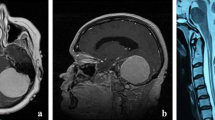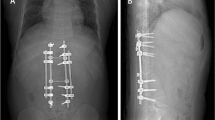Abstract
Background
Posterior fossa tumors most commonly occur in children. They frequently present with raised intracranial pressure and may have tonsillar herniation. The symptomatology is predominantly directed towards the tumor. The occurrence of syringomyelia in such cases is most unusual. Symptomatic syringomyelia is rare.
Case report
We describe a case of a pilocytic astrocytoma of the cerebellum in a 13-year-old girl who presented with clinical features of progressively worsening raised intracranial pressure and secondary tonsillar herniation and cervical syringomyelia. Magnetic resonance (MR) imaging showed a large midline inhomogenously enhancing vermian tumor causing moderate obstructive hydrocephalus. In addition, the cerebellar tonsils herniated down to the C2 level, and there was a centrally located syrinx from C2–T1. The tumor was resected through a suboccipital craniectomy. At follow-up after 3 months, MR imaging demonstrated total resolution of tonsillar herniation and cervical syringomyelia.
Conclusions
The occurrence of tonsillar herniation and syringomyelia in association with a slow growing benign tumor like pilocytic astrocytoma of the cerebellum is uncommon. The blockade of normal cerebrospinal fluid circulation pathway at the foramen magnum is the crucial factor. Surgical extirpation of the tumor restores the normal cerebrospinal fluid circulation at the foramen magnum and produces an excellent outcome. The need for an additional surgical procedure for treatment of associated tonsillar herniation and syringomyelia can be avoided. Volumetric assessment of the posterior fossa may provide a better understanding of the pathophysiology of syringomyelia in such patients.


Similar content being viewed by others
References
Aboulker J (1979) La syringomyelie et les liquids intra-rachidiens. Neurochirurgie (Suppl):9–144
Anegawa S, Hayashi T, Torigoe R, Iwaisako K, Higashioka H (1997) Cerebellopontine angle meningioma causing asymptomatic syringomyelia—case report. Neurol Med Chir (Tokyo) 37:624–626
Armounda RA, Citrin CM, Roley KT, Ellenboen RG (1994) Quantitative cine-mode magnetic resonance imaging of Chiari I malformations: an analysis of cerebrospinal fluid dynamics. Neurosurgery 35:214–224
Arunkumar MJ, Korah I, Chandy MJ (1998) Dynamic CSF flow study in the pathophysiology of syringomyelias associated with arachnoid cysts of the posterior fossa. Br J Neurosurg 12:33–36
Ball MJ, Dayan AD (1972) Pathogenesis of syringomyelia. Lancet 2:799–801
Banna M (1998) Syringomyelia in association with posterior fossa cysts. Am J Neuroradiol 9:867–873
Bhatoe HS (2004) Tonsillar herniation and syringomyelia secondary to a posterior fossa tumor. Br J Neurosurg 18:70–71
Bindal AK, Dunsker SB, Tew JM Jr (1995) Chiari I malformation: classification and management. Neurosurgery 37:1069–1074
Cano G, Anderson M, Kutschback P, Borden J, Saris S (1993) Hydromyelia associated with a posterior fossa cyst. Surg Neurol 40:512–515
Conti C, Lungardi P, Bozzao A, Liccardo G, Fraioli B (2003) Syringomyelia associated with hydrocephalus and Blake's pouch Cyst: case report. Spine 28:E279–E283
Davis CHG, Symon L (1989) Mechanisms and treatment in post-traumatic syringomyelia. Br J Neurosurg 3:669–674
De Reuck J, Alva J, Roels H, vander Eecken H (1974) Relation between syringomyelia and von Hippel–Lindau's disease. Eur Neurol 12:116–127
D'Osvaldo DH, Otero JM, Mosconi JB, Oviedo JD (2002) Regression of symptomatic syringomyelia after resection of posterior fossa tumor. Acta Neurochir (Wien) 144:385–388
Ellertsson AB, Greitz T (1970) The distending force in the production of communicating syringomyelia. Lancet 1:1234
Enzmann DR, Pelc NfsJ (1991) Normal flow patterns with phase-contrast cine MRI imaging. Radiology 178:467–474
Fukui K, Kito A, Iguchi I (1993) Asymptomatic syringomyelia associated with cerebellopontine angle meningioma. Neurol Med Chir (Tokyo) 33:833–835
Gardner WJ, Angel J (1959) The mechanism of syringomyelia and its surgical correction. Clin Neurosurg 6:131–140
Goel A, Desai K (2000) Surgery for syringomyelia: an analysis based on 163 surgical cases. Acta Neurochir (Wien) 142:293–301
Goel A, Bhatjiwale M, Desai K (1998) Basilar invagination: a study based on 190 surgically treated patients. J Neurosurg 88:962–968
Hinokuma K, Ohama E, Oyanagi K, Kakita A, Kawai K, Ikuta F (1992) Syringomyelia: a neuropathologic study of 18 autopsy cases. Acta Pathol Jpn 42:25–34
Hirata Y, Matsukado Y, Kaku M (1985) Syringomyelia associated with a foramen magnum meningioma. Surg Neurol 23:291–294
Jain R, Sawlani V, Phadke R, Kumar R (2000) Retrocerebellar arachnoid cyst with syringomyelia: a case report. Neurol India 48:81–83
Jaiswal AK, Chandra PS (2001) Cerebellopontine angle meningioma with acquired Chiari and syringomyelia: neuroimage. Neurol India 49:323
Kan S, Fox AJ, Vinuela F, Barnett HJM, Peerless SJ (1983) Delayed CT metrizamide enhancement of syringomyelia secondary to tumor. Am J Neuroradiol 4:73–78
Karttunen A, Heikkinen E, Tuominen J, Jartti P (2002) Secondary syringomyelia disappearing after removal of tentorial meningioma. Acta Neurochir (Wien) 144:741–742
Klekamp J, Samii M, Tatagiba M, Sepehrnia A (1995) Syringomyelia in association with tumors of the posterior fossa. Pathophysiological considerations, based on observation on three related cases. Acta Neurochir (Wien) 137:38–43
Kumar C, Panagapoulos K, Kalbag RM, McAllister V (1987) Cerebellar astrocytoma presenting as a syringomyelic syndrome. Surg Neurol 27:187–190
Levine DN (2004) The pathogenesis of syringomyelia associated with lesions at the foramen magnum: a critical review of existing theories and proposal of a new hypothesis. J Neurol Sci 220:3–21
Lhermitte, Boveri (1912) Sur un cas de cavite medullaire consecutive a une compression bulbaire chez l'homme et etude experimental de cavites spinales produites par la compression. Rev Neurol 23:385–393
Li KC, Chui MC (1987) Conventional and CT Metrizamide myelography in Arnold Chiari I malformation and syringomyelia. Am J Neuroradiol 8:11–17
Logue V, Edwards MR (1981) Syringomyelia and its surgical treatment—an analysis of 75 patients. J Neurol Neurosurg Psychiatry 44:273–284
Marcus CD, Galeon M, Peruzzi P, Bazin A, Bernard MH, Pluot M, Menanteau B (1996) Lhermitte–Duclos disease associated with syringomyelia. Neuroradiology 38:529–531
Milhorat TH, Capocelli AL Jr, Anzil AP, Kotzen RM, Milhorat RH (1995) Pathological basis of spinal cord cavitation in syringomyelia: analysis of 105 autopsy cases. J Neurosurg 82:802–812
Milhorat TH, Capocelli AI Jr, Kotzen RM, Bolognese P, Heger IM, Cottrell JE (1997) Intramedullary pressure in syringomyelia: clinical and pathophysiological correlates of syrinx distension. Neurosurgery 41:1102–1110
Nishio S, Matsuno H, Fukui M, Tateishi J, Kitamura K (1982) Cerebellar medulloblastoma associated with lumbosacral syringomyelia. J Neurol 227:67–73
Oldfield EH, Muraszko K, Shawker TH, Patronas NJ (1994) Pathophysiology of syringomyelia associated with Chiari I malformation of the cerebellar tonsils: implications for diagnosis and treatment. J Neurosurg 80:3–15
Pillay PK, Awad IA, Little JR, Hahn JF (1991) Symptomatic Chiari malformation in adults: a new classification based on magnetic resonance ima1ging with clinical and prognostic significance. Neurosurgery 28:639–645
Quencer RM, Post MJD, Hinks RS (1990) Cine MRI in the evaluation of normal and abnormal CSF flow: intracranial and intraspinal studies. Neuroradiology 32:371–391
Sakaki T, Tsunoda S, Morimoto T, Utsumi S (1990) Chiari I malformation in the aged initiated by mechanical factors? Report of three cases. Neurol Med Chir (Tokyo) 30:324–328
Sgaramella E, Perria C (1996) Regression of syringomyelia after removal of a posterior fossa epidermoid tumor. Br J Neurosurg 10:409–411
Sherman JL, Citrin CM, Bowen BJ, Gangarosa RE (1986) MR demonstration of cerebrospinal fluid flow by obstructive lesions. Am J Neuroradiol 7:571–579
Sieben G, Sieben-Praet M, DeReuck J, De Coster W, Remouchamps A, Roels H, vander Eecken H (1980) Dumb-bell Sarcoma of the foramen jugulare with syringomyelia. A radio induced tumor? J Neurol 222:219–225
Stoodley MA, Gutschmidt B, Jones NR (1999) Cerebrospinal fluid flow in an animal model of noncommunicating syringomyelia. Neurosurgery 44:1065–1075
Tachibana S, Harada K, Abe T, Yamada H, Yokata A (1995) Syringomyelia secondary to tonsillar herniation caused by posterior fossa tumors. Surg Neurol 43:470–477
Tauber ES, Langworthy OR (1935) A study of syringomyelia and the formation of cavities in the spinal cord. J Nerv Ment Dis 81:245–264
Tokime T, Okamoto S, Yamagata S, Konishi T (1997) Syringomyelia associated with a posterior fossa cyst. Illustration of two cases. J Neurosurg 86:907
Williams B (1986) Progress in syringomyelia. Neurol Res 8:130–145
Williams B (1991) Pathogenesis of syringomyelia. In: Batzdorf U (ed) Syringomyelia: current concepts in diagnosis and treatment. Williams & Wilkens, Baltimore, MD, pp 59–90
Williams B, Timperley WR (1976) Three cases of communicating syringomyelia secondary to midbrain gliomas. J Neurol Neurosurg Psychiatry 40:80–88
Yasha TC, Mohanty A, Radhesh S, Santosh V, Das S, Shankar SK (1998) Infratentorial dysembryoplastic neuroepithelial tumor (DNT) associated with Arnold–Chiari malformation. Clin Neuropathol 17:305–310
Zager EL, Ojemann RG, Poletti CE (1990) Acute presentations of syringomyelia. Report of three cases. J Neurosurg 72:133–138
Author information
Authors and Affiliations
Corresponding author
Rights and permissions
About this article
Cite this article
Muzumdar, D., Ventureyra, E.C.G. Tonsillar herniation and cervical syringomyelia in association with posterior fossa tumors in children: a case-based update. Childs Nerv Syst 22, 454–459 (2006). https://doi.org/10.1007/s00381-005-0027-x
Received:
Published:
Issue Date:
DOI: https://doi.org/10.1007/s00381-005-0027-x




